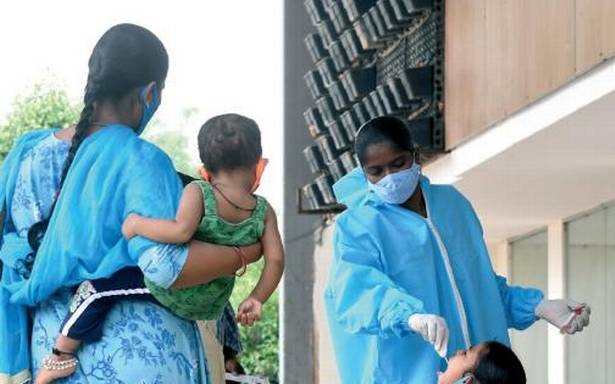Though there is no certainty about another virus surge, govt. is implementing a multi-pronged strategy focussing on mother and child care, emerging wiser from the second wave experience
Around the third week of February, the State was reporting less than 50 new infections and a couple of deaths a day following a year-long fight against the COVID-19 pandemic.
Having witnessed over a hundred deaths and 10,000 infections a day during the peak of the first wave of the pandemic, none, including the government authorities, expected that the State would go through the entire ordeal once again in the next three months.
As the second wave neared peak, all the resources, including medical staff, infrastructure, testing capacity, medicines and medical oxygen were exhausted until ad hoc arrangements on a war-footing were made by the Health Department to meet the additional requirements.
Now, three-and-a-half months after the second wave began, at a time when the incidence of infection was on a downward trend continuously for weeks, the government was again preparing to face a likely third wave which could hit any time in the coming months.
The partial curfew which was imposed to contain the spread of coronavirus and its variants has been brought down from 18 hours to 12 hours as the test positivity rate is slowly but steadily coming down. The government maintains that there is no scientific evidence to the theory of the possibility of a third wave but it has to be prepared to face the worst given the past experiences.
Based on reports that children could be most affected, the government has come up with a multi-pronged strategy of vaccinating mothers of children aged below five years so that they will be able to take care of their wards in future in hospitals and ramping up infrastructure to treat children who require special treatment procedures, infrastructure and care.
Task force
To start with the government constituted the ‘Paediatric COVID-19 Task Force Committee’ which studied the possibilities of a third wave, estimated the number of persons in general and children in particular likely to get infected and the infrastructure required.
As of June 16, 25% of the 18.7 lakh mothers were vaccinated with at least one dose.
Testing was one area the government failed to ramp up until the third week of April by when the second wave started to surge.
The Health Department has gradually increased testing capacity from around 40,000 a day to one lakh as of June 18.
The government is now making arrangements to set up 19 new RT-PCR laboratories at ₹15 crore in addition to the existing 14 virology laboratories. This could double the testing capacity and help the government test and track more positive cases in a short period.
Oxygen supply
The government also ran short of oxygen during the peak of the second wave as the requirement shot up to 900 metric tonnes a day. So it took up the establishment of permanent oxygen plants in 45 hospitals and also introduced the ‘AP Industrial Gases and Medical Oxygen Manufacturing Policy 2021-22’ to encourage private oxygen generation plants.
A major part of the fight against COVID-19 also lies with the public who need to continue to follow COVID-appropriate behaviour even after vaccination, according to experts.
As of June 18, the State administered 1.24 crore doses of vaccines and only 26.4 lakh people were fully vaccinated. About 71.88 lakh people got at least one dose of the vaccine.
Meanwhile, district administrations are focusing on COVID-19 spread in rural areas where more cases are being reported of late.
Source: Read Full Article

